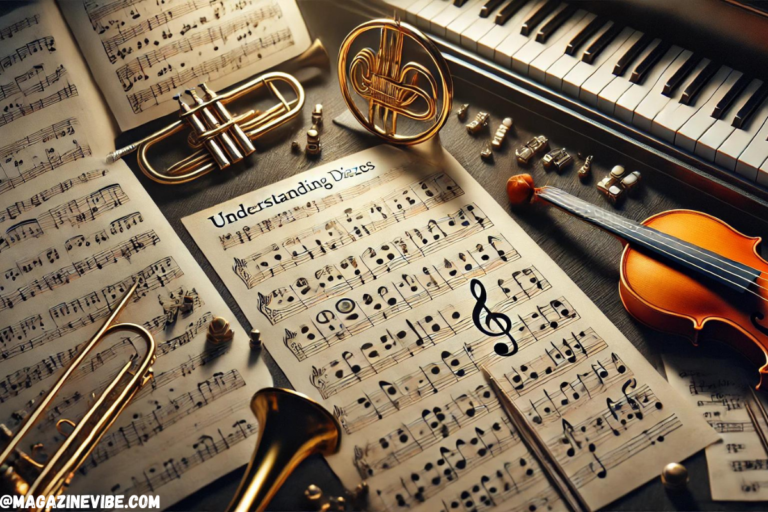What Are Diezes?
Diezes are musical symbols that raise the pitch of a note by one semitone. In music, diezes are often referred to as sharps. A sharp symbol (#) represents diezes in written music. When placed before a note, it tells musicians to play a higher version of the note.
The significance of diezes is important in music theory. They change the sound of a note, making it sharper or brighter. This helps create different moods or tones in songs. Diezes are common in many musical compositions, especially in genres like classical and jazz.
The word diezes comes from the French word “dièse,” which means sharp. This term originated from ancient music theory in Europe. Over time, musicians around the world adopted the use of diezes in their music.
Historical Background of Diezes
The history of the term diezes dates back to early European music theory. The word diezes comes from the French term “dièse,” which means sharp. Musicians used diezes to show that a note should be raised by one semitone. This practice began in classical music and spread to many other styles of music.
Over time, the usage of diezes has evolved. In the past, diezes were mostly seen in complex classical compositions. Today, diezes are used in a wide range of music genres, from classical to modern pop, rock, and jazz. Musicians now see diezes as an important part of creating different sounds and emotions in music.
Diezes in Music Theory
The concept of diezes in music notation is simple. Diezes are symbols that raise a musical note by one semitone. In written music, a sharp symbol (#) shows a diezes. For example, if you see a C note with a sharp symbol, it becomes C# (C sharp), which is a higher version of C.
Diezes alter musical notes by changing their pitch. This creates a brighter, sharper sound. It allows musicians to add variation to melodies and harmonies. Diezes can make the same note sound different, creating more musical options.
In key signatures and scales, diezes play an important role. Key signatures often include diezes to show which notes should be sharp throughout a song. For example, in the key of G major, all F notes become F# (F sharp). In scales, diezes help form the structure of major and minor scales, making them unique.
Diezes vs Flats: What’s the Difference?
Diezes (sharps) and flats are both symbols used in music to change the pitch of a note. The key difference is that diezes raise the pitch by one semitone, while flats lower it by one semitone. For example, a C# (C sharp) is a half-step higher than C, while a Db (D flat) is a half-step lower than D. Both notes, C# and Db, sound the same, but they are written differently.
In music notation, diezes are shown with a sharp symbol (#), while flats use a flat symbol (♭). Musicians use diezes and flats to change the mood or tone of a piece. Diezes give notes a brighter sound, while flats often create a softer tone. Both symbols are important in key signatures, where they tell musicians which notes should be altered throughout the composition.
Why Are Diezes Important in Musical Composition?
Diezes are important in musical composition because they help create unique melodies and harmonies. By raising the pitch of a note, diezes add variety and complexity to music. This allows composers to create fresh and interesting sounds. Diezes are often used to build tension, resolve melodies, or make harmonies more colorful.
Diezes also influence the emotional tone of music. They can make a song feel brighter, sharper, or more intense. When used in the right places, diezes can change the mood of a piece, adding excitement, drama, or energy to the music.
How to Identify Diezes in Sheet Music
Recognizing diezes in written music is easy once you know what to look for. A sharp symbol (#) before a note shows a diezes. This means the note should be played one semitone higher. For example, if you see a sharp symbol before a C, you play C# instead of C. Diezes can also appear in key signatures, where they apply to specific notes throughout the entire piece.
Practical examples of diezes in compositions are common in many genres. In the key of G major, you’ll always find F# (F sharp) instead of F. In the key of D major, F# and C# are used. Many classical and modern songs use diezes to create a bright or energetic sound. By learning to spot the sharp symbol, you can easily identify diezes in any sheet music.
Common Misunderstandings About Diezes
There are some common misunderstandings about diezes in music. One misconception is that diezes always make a note sound higher in every context. While diezes do raise a note by one semitone, the effect may not always feel “higher” depending on the musical piece or key.
Another misunderstanding involves enharmonic equivalence. Many people are confused by the fact that diezes and flats can sound the same but are written differently. For example, C# (C sharp) and Db (D flat) are played the same on most instruments, but they are not the same note in theory. This is called enharmonic equivalence. Though they sound alike, the context of the music decides whether a diezes (sharp) or flat is used.
Learning Diezes: Practical Tips for Musicians
Mastering diezes requires practice and familiarity with musical notation. To read and play diezes on instruments like the piano or guitar, it’s important to recognize the sharp symbol (#) and understand how it changes the note. Start by learning scales with diezes. For example, practice playing the G major scale, which includes F#. This helps you get used to finding and playing sharp notes.
Exercises for improving sharp note recognition include sight-reading sheet music with lots of diezes. Focus on scales and arpeggios in sharp keys, like D major or A major, which contain multiple diezes. Another good exercise is to play simple melodies in different keys, then transpose them into sharp keys to reinforce your ability to identify and play diezes quickly.
Diezes in Popular Music
Many popular songs prominently feature diezes to create memorable melodies and harmonies. For example, “Pachelbel’s Canon” often uses D major, which has two diezes (F# and C#). Another popular song, “Sweet Child o’ Mine” by Guns N’ Roses, includes various diezes that add to its distinct sound. Similarly, “Shake It Off” by Taylor Swift also uses diezes effectively to enhance its catchy tune.
Different music genres make use of diezes in unique ways. In classical music, diezes help build complex harmonies and dramatic melodies. In jazz, musicians often use diezes to add color and tension to their improvisations. In pop and rock, diezes create catchy hooks and memorable choruses, making the music feel lively and engaging. Overall, diezes play a key role in shaping the sound and feel of many popular songs across various genres.
Conclusion
Diezes are crucial in music, significantly influencing how melodies and harmonies are created. They raise the pitch of notes, allowing for a richer and more dynamic sound. The use of diezes adds variety and depth to musical compositions, making them more interesting and engaging for listeners.
In different music genres, diezes help shape the emotional tone, creating excitement, tension, or brightness. They are essential in key signatures and scales, guiding musicians in their performances. Overall, diezes play a vital role in musical expression, helping to convey feelings and ideas through sound. Understanding diezes enriches the experience of both playing and listening to music.
FAQs
Q. What are diezes in music?
Diezes are musical symbols that raise the pitch of a note by one semitone. They are represented by the sharp symbol (#) in written music.
Q. How do diezes affect the sound of a note?
Diezes make a note sound higher. For example, a C note becomes C# (C sharp) when a diezes is applied.
Q. Are diezes the same as sharps?
Yes, diezes and sharps are the same. The term diezes is often used in music theory, while “sharp” is the more common term for performers.
Q. How do I recognize diezes in sheet music?
Look for the sharp symbol (#) placed before a note in the sheet music. This indicates that the note should be played one semitone higher.
Q. What is enharmonic equivalence related to diezes?
Enharmonic equivalence refers to notes that sound the same but are written differently, such as C# (C sharp) and Db (D flat). They are used in different musical contexts.
Q. Why are diezes important in musical composition?
Diezes allow composers to create unique melodies and harmonies. They also influence the emotional tone of a piece, adding brightness and tension.
Q. Can you give examples of songs that use diezes?
Yes, songs like “Pachelbel’s Canon,” “Sweet Child o’ Mine,” and “Shake It Off” prominently feature diezes in their melodies and harmonies.
Q. What are some exercises to improve sharp note recognition?
Practice sight-reading music with many diezes, play scales in sharp keys, and transpose melodies into sharp keys to strengthen your recognition skills.


